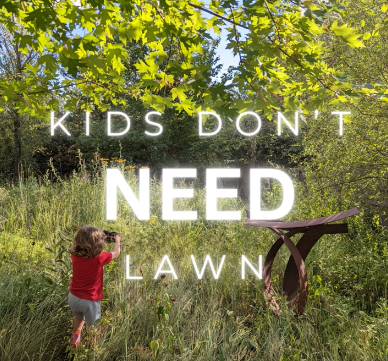First, it's well established that kids need to be outside running around, touching, breathing it all in, getting dirty. Richard Louv's books are a great starting point. Kids who spend time outside are less likely to develop allergies as they are exposed to a wild world of microbes. Kids playing in nature develop better balance and stamina, they cultivate empathy for others through interaction with wildlife, and they become more creative in their thinking and response to challenging situations. Kids with classroom window views of more diverse habitat have higher tests scores and are better able to work in groups. Heck, hospital patients with views of trees recover faster. KIDS NEED NATURE. And so do adults. Get your 10 minutes of sun at midday to get that good dose of daily vitamin D, for example.
So back to ticks. It's easy to see the symptom -- there's a tick latched on to my skin -- and freak out. I do. I have. I will continue to do so. But saying we need to protect kids form interaction with nature because of ticks is a bit problematic because the benefits far outweigh the risks (maybe true for sending kids to school with no HEPA air filtration).
Ticks will thrive even more in the future thanks to us. We are a big problem. Of course we can also be the solution but that's unlikely to happen. Tick populations and their diseases will thrive with climate change: as winters warm, as ecoregions shift and change, ticks will grow in populations.
Habitat loss is a big one, too, in particular if we focus on lyme disease and especially in the northeast, where I'd say 75% of tick concerns come from when I have the "kids don't need lawn" conversation. Deer are not vectors for lyme disease (even though deer do breed ticks like crazy) -- white-footed mice are. Without large, intact habitats, as well as fewer fragmented habitat like we see in most urban and suburban and even semi rural areas, those mice will thrive due to a lack or predators. Fewer foxes and wolves and coyotes and owls and snakes (yes, snakes are good!) mean more mice.
As for what we can directly control in our home landscapes, hey, I've seen ticks on our front door. Still, there are some things we can do design wise in small suburban spaces and larger rural ones. The low-hanging fruit is simply wider paths to explore the landscape, say 4-6 feet wide. Ticks usually latch on by questing, which is reaching out their front legs into the air as they balance on the tips of foliage. We can also, obviously, work to increase the biodiversity and habitat structure to foster predators. (Do note that the opossums-eat-10,000-ticks-a-day-thing is a myth.) Little patches of lawn make nice places to picnic or stargaze in, while also providing negative space -- a design technique that helps show order and intention in a wilder landscaper (it's a cue to care).
If you are able to use fire in your landscape, it's a great management tool to increase biodiversity and reduce ticks. Ticks don't like fire, says Kyle Lybarger of Native Plant Habitat Project. In fact, you'll find more ticks in woodlands than grasslands. As for No Mow May, mowing less does not increase tick populations. But you should probably also not participate in No Mow May. If you live in the Great Plains, the invasion of eastern red cedar trees increases tick populations.
Ticks aren't going anywhere. And they suck. Ahem. I will scream and nearly pass out when I find one on me like anyone else, but knowledge is power -- and habitat is key in reducing tick populations AND in fostering physical and mental health for ourselves.



 RSS Feed
RSS Feed

